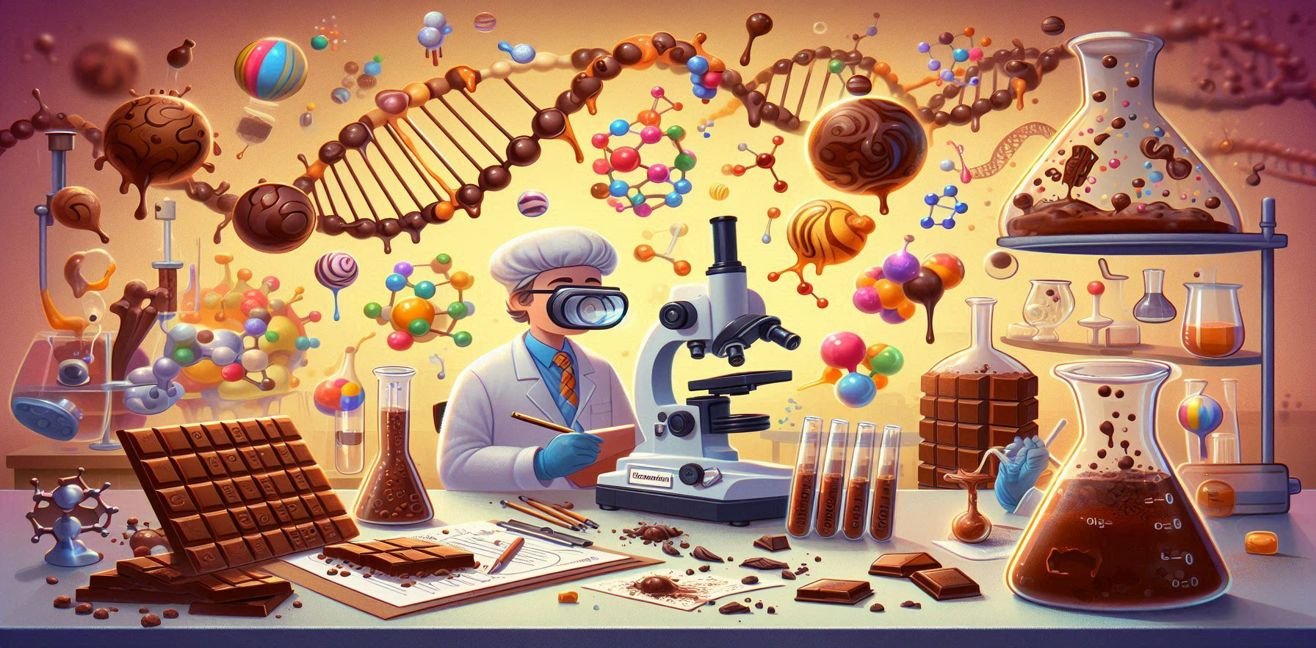Hello, dear science and chocolate enthusiasts! 💫 Today, we are embarking on a journey not just into the kitchen but into the mysterious world of molecules, biochemical reactions, and our nervous system. Our topic: chocolate! Yes, it’s not just a sweet treat, but a happiness and flavor experience blended with science.
🔬 The Chemical Components of Chocolate
Chocolate is a complex molecular mixture derived from cocoa beans. Its main components include:
- Cocoa Butter: Composed of triglycerides, with a melting point of 30–32°C. Since this is close to human body temperature, chocolate melts easily on your fingers and tongue.
- Theobromine (C₇H₈N₄O₂): A mild central nervous system stimulant. Similar to caffeine but with a softer, longer-lasting effect.
- Phenylethylamine (C₈H₁₁N): Known as the “love and happiness molecule,” it triggers serotonin and dopamine release in the brain, explaining the mild pleasure and excitement felt when eating chocolate.
- Anandamide (C₂₂H₃₇NO₂): A neurotransmitter affecting the endocannabinoid system, enhancing feelings of reward and happiness in the brain.
- Flavonoids: Possess antioxidant properties, improve blood flow, and are beneficial for cardiovascular health. Particularly abundant in dark chocolate.
Together, these components create a molecular mix that provides not only sweetness but also biochemical happiness and energy.
🌡️ Physical Properties: Melting and Crystallization
The texture and melting behavior of chocolate are related to the crystalline structure of cocoa butter. Cocoa butter can exist in six different crystal forms (polymorphs), but the most stable and smooth form is Form V (β-crystalline). This form gives chocolate its gloss, snap, and smooth melting quality.
- Melting Point: Around 30–32°C, close to body temperature, which is why chocolate melts quickly on your tongue.
- Tempering Process: Controlled heating and cooling at different temperatures regulate crystallization, ensuring both aesthetic and technical quality in chocolate.
👅 Taste and Sensory Science
Tasting chocolate is not limited to the tongue; it combines smell, touch, and sight. Chocolate consumption is a multisensory experience:
- Taste Receptors: Sweet and mildly bitter compounds activate the brain’s reward centers. Dark chocolate, with its phenolic compounds, offers a rich taste and health benefits.
- Aroma Molecules: Cocoa aroma reaches the nasal epithelium via volatile compounds, interacting with the limbic system in the brain to evoke nostalgia and pleasure.
- Melting in the Mouth: Slowly melting chocolate allows flavonoids and aromatic compounds to be fully perceived, providing a more intense flavor experience.
🧠 Neuroscience: Brain and Happiness
Eating chocolate initiates a complex neurochemical process in the brain:
- Dopamine Release: Activates the reward system, creating pleasure and satisfaction.
- Serotonin Increase: Improves mood, promoting calmness and happiness.
- Endorphin Release: Acts as a natural painkiller and enhances well-being.
In short, eating chocolate biochemically presses your brain’s “feel happy” button! 😄
🧪 At-Home Laboratory Experiments
You can perform simple scientific experiments at home:
- Melt chocolate at different temperatures and observe the aroma intensity.
- Compare dark, milk, and white chocolate: How do differences in molecular composition affect taste and melting properties?
- Practice tempering to observe crystal structure and texture.
These experiments reveal the fascinating intersection of culinary delight and scientific principles.
💡 Conclusion: Where Chocolate Meets Science
Chocolate is not just a sweet treat; it is a scientific marvel filled with molecules, physics, and neuroscience. The combination of taste, aroma, texture, and our brain’s biochemistry explains why eating chocolate is so enjoyable. Next time you savor chocolate, think about the molecules, physical laws, and neurological effects behind each bite.
And remember, my love, when science meets chocolate, laughter, happiness, and learning are inevitable! 🍫🔬😄




